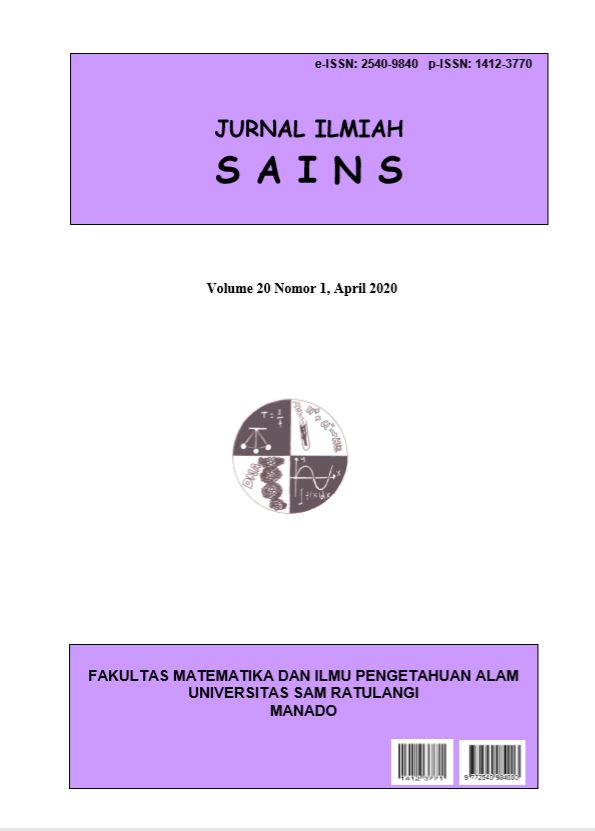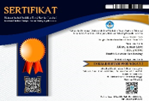Adsorpsi Metilen Biru Pada Hidroksiapatit Dari Tulang Ikan Kakap Merah
DOI:
https://doi.org/10.35799/jis.20.1.2020.25758Abstract
Adsorpsi Metilen Biru Pada Hidroksiapatit Dari Tulang Ikan Kakap Merah
ABSTRAKPenelitian yang bertujuan untuk mempelajari adsorpsi metilen biru pada hidroksiapatit yang diperoleh dari tulang ikan kakap merah (Lutjanus sp.) telah dilakukan. Tulang dikalsinasi dalam tanur pada 600, 800, dan 1000 oC, digerus, dan diayak dengan ayakan 100 mesh. Material tersebut selanjutnya digunakan dalam eksperimen adsorpsi dan data yang diperoleh dianalisis menggunakan model isoterm adsorpsi Langmuir, Freundlich, dan Dubinin-Raduskevich. Hasil penelitian menunjukkan bahwa semakin tinggi suhu kalsinasi, semakin rendah kapasitas adsorben untuk mengadsorpsi metilen biru. Energi adsorpsi yang dihitung berada dalam kisaran 0,84-1,14 kJ mol-1 yang mengindikasikan bahwa metilen biru teradsorpsi secara fisik pada adsorben dan adsorpsi cenderung mengikuti model isoterm adsorpsi Freundlich.
Kata kunci: adsorpsi, hidroksiapatit, kakap merah, metilen biru
Â
Adsorption of Methylene Blue on Hydroxyapatite from Red Snapper Fish Bones
 ABSTRACT
A research aimed to study the adsorption of methylene blue on hydroxyapatite obtained from red snapper fish bones (Lutjanus sp.) was performed. The bones were calcined in a furnace at 600, 800, and 1000 oC and ground to pass a 100 mesh sieve. The materials were used in the adsorption experiment and the data obtained were analyzed using Langmuir, Freundlich, and Dubinin-Raduskevich adsorption isotherm models. The results showed that the higher the calcination temperature, the lower the capacity of the adsorbent to adsorb methylene blue. Calculated adsorption energy which was in a range of 0.84-1.14 kJ mol-1 indicated that the dye was adsorbed physically on the adsorbent and the adsorption could be well described by Freundlich adsorption isotherm model.
Keywords: adsorption, hydroxyapatite, red snapper, methylene blue
References
Allam, K., A. El Bouari, B. Belhorma & L. Bih. 2016. Removal of Methylene Blue from Water Using Hydroxyapatite Submitted to Microwave Irradiation. J. Water Resour. Prot., 8:358-371.
Dabiri, S.M.H., A. A. Rezaie, M. Moghimi & H. Rezaie. 2018. Extraction of Hydroxyapatite from Fish Bones and Its Application in Nickel Adsorption. BioNanoScience. doi.org/10.1007/s12668-018-0547-y.
Elliot J.C. 1971. Monoclinic Space Group of Hydroxyapatite. Nat. Phys. Sci., 230.
Jia, P., H. Tan, K. Liu & W. Gao. 2018. Removal of Methylene Blue from Aqueous Solution by Bone Char. Appl. Sci., 8:1903.
Li, J., T. Zhang, L. Cheng, M. Guo, S. Wang, R. Ran & Y. Ma. 2016. An investigation on windmill palm leaf sheath fiber powder-based activated carbon for dye adsorption. Wood and Fiber Science, 48(3):143-155.
Mobasherpour, I., E. Salahi & M. Pazouki. 2012. Comparative of the removal of Pb2+, Cd2+ and Ni2+ by nano crystallite hydroxyapatite from aqueous solutions: Adsorption isotherm study. Arab J. Chem., 5:439-446.
Pastero, L., M. Bruno & D. Aquillano. 2017. About the Genetic Mechanisms of Apatites: A Survey on the Methodological Approaches. Minerals, 139(7): 1-21.
Peng, Q., F. Yu, B. Huang & Y. Huang. 2017. Carbon-Containing Bone Hydroxyapatite Obtained from Tuna Fish Bone with High Adsorption Performance for Congo Red. RSC Adv., 7:26968-26973.
Piccirillo, C., M.M. Pintado & P.M.L. Castro. 2013. Hydroxyapatite and Calcium Phosphates from Marine Sources: Extraction and Characterization. dalam Kim (Ed.). Marine Biomaterials, Characterization, Isolation, and Applications. CRC Press. Taylor Francis. Florida
Piccirillo, C., R.C. Pular, E. Costa, A. Santos-Silva, M.M.E. Pintado & P.M. L. Castro. 2015. Hydroxyapatite-based Materials of Marine Mrigin: A Bioactivity and Sintering Study. Mater. Sci. Eng. C 51:309–315.
Posner, A. S., A. Perloff & A.F. Diorio. 1958. Refinement of the Hydroxyapatite Structure. Acta Cryst., 11:308-309.
Santhosh, C., P. Kollu, S. Doshi, M. Sharma, D. Bahadur, M.
Vanchinathan, P. Saravanan, B-S. Kim & A. N. Grace. 2014. Adsorption, photo-degradation and antibacterial study of Graphene-Fe3O4 nanocomposite for multipurpose water purification application. RSC Adv., 4:28300-28308.
Shaibu, S. E., F. A. Adekola, H. I. Adegoke & O.S. Ayanda. 2014. A Comparative Study of the Adsorption of Methylene Blue onto Synthesized Nanoscale Zero-Valent Iron-Bamboo and Manganese-Bamboo Composites. Materials, 7:4493-4507.
Venkatesan,J., Z.J. Qian, B. Ryu, N.V. Thomas & S-K. Kim. 2011. A Comparative Study of Thermal Calcination and an Alkaline Hydrolysis Method in the Isolation of Hydroxyapatite from Thunnus obesus Bone. Biomed. Mater., 6:1-12.
Wainwright, M., K. Crossley. 2002. Methylene Blue-A Therapeutic Dye for All Seasons. J. Chemother., 14:431-443.
Wei, W., L. Yang, W.H. Zhong, S.Y. Li, J. Cui & Z.G. Wei. 2015. Fast Removal of Methylene Blue from Aqueous Solution by Adsorption onto Poorly Crystalline Hydroxyapatite Nanoparticles. Dig. J. Nanomater. Biostruct., 19:1343-1363.
Yamamura, H., V.H.P. da Silva, P.L.M. Ruiz, V. Ussui, D.R.R. Lazar, A.C.M. Renno & D.A. Ribeiro. 2018. Physico-Chemical Characterization and Biocom-patibility of Hydroxyapatite Derived from Fish Waste. J. Mech. Behavior Biomed. Mater., 80:137-142.
Yuan, N., H. Cai, T. Liu, Q. Huang & X. Zhang. 2019. Adsorptive removal of methylene blue from aqueous solution using coal fly ash-derived mesoporous silica material. Adsorption Science & Technology, 37(3–4): 333–348.







